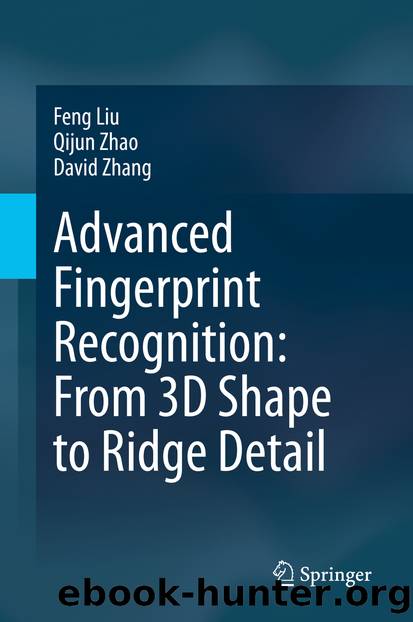Advanced Fingerprint Recognition: From 3D Shape to Ridge Detail by Feng Liu & Qijun Zhao & David Zhang

Author:Feng Liu & Qijun Zhao & David Zhang
Language: eng
Format: epub
ISBN: 9789811541285
Publisher: Springer Singapore
8.1 Introduction
Since Galton quantified the uniqueness of fingerprints in 1872, fingerprints have been widely used for human identification [1–3]. Most of existing automatic fingerprint recognition systems (AFRS) use the minutia features on finger-prints, i.e. the terminations and bifurcations of fingerprint ridges [4–6], for recognition. Although they can achieve good recognition accuracy and have been used in many civil applications, their performance still needs much improvement when a large population is involved or a high security level is required. One solution to enhancing the accuracy of AFRS is to employ more features on fingerprints other than only minutiae [7–9].
Fingerprints are identified by their features. Generally, fingerprint features can be divided into three levels [10]. Level 1 features are the overall global ridge flow patterns, including singular points, deltas and cores. Level 2 features refer to ridge ending and ridge bifurcation, namely minutiae points and level 3 features are defined as the dimensional attributes of the ridges, such as sweat pores, ridge contour, and ridge edge features, which are fine details on ridges and require high resolution imaging techniques to reliably capture [10]. Such requirements limit the use of Level 3 features in conventional AFRS. Thanks to the advances in imaging techniques and the demand for more secure biometric systems, recently researchers have been paying more and more attention to using Level 3 features in AFRS. Roddy and Stosz [11], and Parsons et al. [12] statistically analyzed the discriminative power of pores and validated the effectiveness of pore configuration in personal identification. The first AFRS using pores was developed by Stosz and Alyea [13]. They combined minutiae and pores to recognize persons. Subsequently, Kryszczuk et al. [14, 15] investigated the contribution of pores to fragmentary fingerprint recognition and showed that the smaller the fingerprint fragments, the greater the benefit of using pores. Then Jain et al. [7, 16] proposed a high resolution fingerprint recognition system which uses features from all the three levels (i.e. ridge orientation fields, minutiae, ridge contours, and pores). Previous studies of fingerprint identification based on Level 3 features are mainly focused on sweat pores. This feature is used for more accurate fingerprint matching because of its large amount and better performance compared to other features [14, 16].
Many studies prove that pores can greatly increase the accuracy of fingerprint recognition [15, 17–22]. Therefore, a precise pore extraction and locating influence the pore matching directly. The accuracy of pore extraction from fingerprints is an important step in whole fingerprint recognition. Before the dynamic anisotropic pore model, existing methods extract pores by using skeleton-tracking-based [11, 13–15] or filtering-based approaches [7, 12, 16, 23]. The skeleton-tracking-based approaches are quite time-consuming and work well only with very high quality fingerprint images [7, 16, 23]. The filtering-based approaches are more efficient and more robust. They use static isotropic pore models to detect pores. As we will see later, however, the pores on real fingerprint images appear anisotropic and vary greatly in scale from fingerprint to fingerprint and from region to region. In this chapter,
Download
This site does not store any files on its server. We only index and link to content provided by other sites. Please contact the content providers to delete copyright contents if any and email us, we'll remove relevant links or contents immediately.
Algorithms of the Intelligent Web by Haralambos Marmanis;Dmitry Babenko(8521)
Test-Driven Development with Java by Alan Mellor(7363)
Data Augmentation with Python by Duc Haba(7261)
Principles of Data Fabric by Sonia Mezzetta(7006)
Learn Blender Simulations the Right Way by Stephen Pearson(6942)
Microservices with Spring Boot 3 and Spring Cloud by Magnus Larsson(6774)
RPA Solution Architect's Handbook by Sachin Sahgal(6175)
Hadoop in Practice by Alex Holmes(6030)
The Infinite Retina by Robert Scoble Irena Cronin(5881)
Jquery UI in Action : Master the concepts Of Jquery UI: A Step By Step Approach by ANMOL GOYAL(5872)
Big Data Analysis with Python by Ivan Marin(5700)
Life 3.0: Being Human in the Age of Artificial Intelligence by Tegmark Max(5401)
Pretrain Vision and Large Language Models in Python by Emily Webber(4659)
Infrastructure as Code for Beginners by Russ McKendrick(4444)
WordPress Plugin Development Cookbook by Yannick Lefebvre(4174)
Functional Programming in JavaScript by Mantyla Dan(4123)
The Age of Surveillance Capitalism by Shoshana Zuboff(4114)
Embracing Microservices Design by Ovais Mehboob Ahmed Khan Nabil Siddiqui and Timothy Oleson(3963)
Applied Machine Learning for Healthcare and Life Sciences Using AWS by Ujjwal Ratan(3937)
